new posts in all blogs
Viewing: Blog Posts Tagged with: Stories for Children, Most Recent at Top [Help]
Results 1 - 25 of 68
How to use this Page
You are viewing the most recent posts tagged with the words: Stories for Children in the JacketFlap blog reader. What is a tag? Think of a tag as a keyword or category label. Tags can both help you find posts on JacketFlap.com as well as provide an easy way for you to "remember" and classify posts for later recall. Try adding a tag yourself by clicking "Add a tag" below a post's header. Scroll down through the list of Recent Posts in the left column and click on a post title that sounds interesting. You can view all posts from a specific blog by clicking the Blog name in the right column, or you can click a 'More Posts from this Blog' link in any individual post.
I first met Nancy Viau at a workshop she presented for the NJ chapter of the Society of Children’s Book Writers and Illustrators Conference in 2011. Her middle grade book SAMANTHA HANSEN HAS ROCKS IN HER HEAD (Amulet 2008) had been published. She, along with some fellow authors, were talking about their books and the group they’d formed called the Kid Lit Authors Club. Here’s Nancy:
First give me some of your own background and how you came to be a children’s book author.
I started writing down ideas and creating silly rhymes when my youngest was about three. I wasn’t sure what to do with the picture books (I use that term loosely because they weren’t even close to being picture books!) that rolled out of my head onto paper, so I joined SCBWI and sat in many, many sessions where I soaked up info on how to write, what to write, and where to send manuscripts. Early on I had success with Highlights, Highlights High Five, Babybug, Ladybug, etc. but no picture book acceptances. A friend encouraged me to write for an older audience so for a while I wrote Op-Ed articles for the Philly Inquirer, popular anthologies, and a mish-mash of parenting magazines. An idea for an older character lead to my middle-grade novel, Samantha Hansen Has Rocks in Her Head, and even after that was published, I never let go of the dream to be a picture book author.
Where and when did the idea for KIDLIT AUTHORS CLUB originate? What’s the philosophy/premise behind the group?
A year after my middle-grade novel came out (2009), I came to the realization that it’s not easy to promote a book and get author gigs. Publishers do not do a lot (*sigh), especially if your book is not a best-seller. Another author, Keri Mikulski, and I thought it might be a good idea to band together with a diverse group of picture book, middle-grade, and young adult authors to help spread the word about our titles. We wanted a book-signing or a general visit to be fun and interactive, an event the entire family could enjoy, and that we could enjoy, too. We wanted to make an irresistible buzz for our books, and never again find ourselves sitting alone at a book signing. 
How many members and from what genres?
Membership fluctuates every year, but we try to keep a balance between PB, MG, and YA. Some years we have 20; sometimes we have as many as 26. We try not to go over 25 or 26 because what happens then is that people step back and let a select few do the work. We all work to find opportunities for signings and presentations by reaching out to librarians, booksellers, teachers, conference directors, festival organizers, and others.
How has being a member of the group changed the way you present and promote your books? What are the advantages of such a group?
I feel like I have a marketing team behind me. Whereas I am one individual who may find a way to promote my books, with the KidLit Authors Club behind me, I have 20+ others who are also promoting my books. Sure, I still do events by myself, but at those events I talk up members’ books, and hand out the club’s bookmarks and marketing materials. We share the love. Big time. A picture book author may come across an event suitable for YA authors and will pass it along. A middle-grade author may find an opportunity to appear on a panel, but picture book authors are needed as well. Voila, we’ve got that! We provide a multi-author resource for bookstore owners and conference or festival organizers looking to fill program spots.
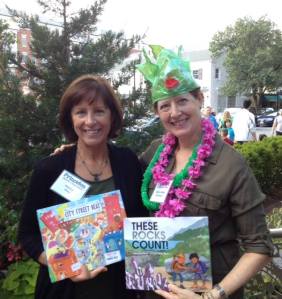
Nancy Viau and Alison Formento, members of the Kid Lit Authors Club
What advice would you give other writers looking to collaborate and form a similar club?
Find others who enjoy getting the word out about their own books, but would be open to helping others do the same. Get together and hash out a plan of action. A marketing group made up of authors can take many forms. Look at groups such as the Liars Club or the “Class of” groups that started with the Class of 2k7 and continued on with the Tenners, Elevensies, and so on. I saw how successful my class was–the Class of 2k8, but felt that limiting a group to authors of novels was not in our best interest. Members of our club all benefit when seasoned authors mentor debut authors, older titles are mentioned in the same breath as current ones, and new titles are celebrated and given a presence.
Any final thoughts?
Working with a group of wonderful people who have the same passion and vision as you is priceless. (I sound like a MasterCard commercial…) It’s really hard being an author—harder than most people think, but it’s much more enjoyable when you don’t have to go it alone.
http://www.kidlitauthorsclub.com
Making every event a celebration of children’s books!
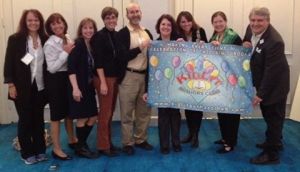
Some Kid Lit Club Authors
Nancy Viau
Nancy Viau is the author of City Street Beat, Storm Song, and Look What I Can Do! (nominated for the 2014-2015 Keystone to Reading Book Award). Her middle-grade title, Samantha Hansen Has Rocks in Her Head, was published in 2008. Viau enjoys presenting assembly programs and writing workshops, and along with the young writers she meets, she finds inspiration in nature, travel, and her job as a librarian assistant.
Website: http://www.NancyViau.com
Facebook: Nancy Viau
Twitter: @NancyViau1


Last month we had the pleasure of discovering some amazing literary devices found in the humble PICTURE BOOK thanks to PB writer Beth Ferry. Beth is back this month with more techniques you can use to enhance your writing and raise it above the mundane. Here’s Beth:
Asyndeton. This involves leaving out conjunctions, such as Reduce. Reuse. Recycle. It is a great way to lower your word count. In the same vein, Polysyndeton is the use of many conjunctions close to one another – “He ran and laughed and jumped with joy.” I use the latter much more than the former. I really like conjunctions.
Internal rhyme. A rhymer at heart, I love all rhyme, but this type of rhyme is my favorite and I try to pepper some internal rhyme even in my non–rhyming stories. It is also known as middle rhyme because a word in the middle of the line usually rhymes with the last word of the line.
Homophones. I love to use these to add depth to my writing. It is easy to confuse homonyms and homophones, so just to clarify: All homonyms are homophones, but not all homophones are homonyms. Homonyms look the same and sound the same, but have different meanings such as bear and rose. Often one version is a noun and the other is a verb. Homophones, on the other hand, SOUND alike, but have different spellings and different meanings. These will seem the most familiar to you (to, too, two). My favorite use of a homonym is this one: “Time flies like an arrow; fruit flies like a banana.” –Groucho Marx.
Euphony. This is basically just the loveliness of sound and the opposite of cacophony, which, I must say, is an amazing word to say out loud. Euphony is created by the use of some of the aforementioned literary devices, especially alliteration, assonance, consonance and rhyme. And just a little tidbit: “Cellar door” is supposed to be the most pleasing sound in the English language. Something to consider and possibly say out loud a few times.
Lastly, there is one literary device picture book writers should absolutely, completely avoid: Periphrasis, which is the use of excessive language and surplus words to convey a meaning that could otherwise be conveyed in fewer words and in a more direct manner. Stay away from this one. Stay far away.
So, picture book writers, pull out your works-in-progress and see if you can identify any of these literary devices in your writing. Then experiment with some new ones. Add a little assonance. Sprinkle in some polysyndeton. Pop in a homophone. It may make a fun and beautiful difference in your writing. 
Beth Ferry lives and writes near the beach. Her debut book, Stick and Stone, will be released on April 7, 2015 by HMH. Land Shark (Chronicle) will be released in Fall 2015 and Pirate’s Perfect Pet (Candlewick) follows in Fall 2016.


By: darlenebeckjacobson,
on 11/16/2014
Blog:
Darlene Beck-Jacobson
(
Login to Add to MyJacketFlap)
JacketFlap tags:
Children's Books,
Books,
Poetry,
Writing,
writing for children,
stories for children,
Tips for writers,
Beth Ferry,
www.hmh.com,
Add a tag
The Use of Literary Devices in Picture Books: Part 1 
by Beth Ferry
As parents, we are constantly teaching our children about the world: rules, facts and essential life truths such as: Be kind. Be patient. Bees sting. Eat your vegetables. Don’t eat the sand. Say please and thank you. Don’t step on that ant. As they grow older, teaching can morph into school related lessons: spelling tools, vocabulary words, and math tricks such as Please Excuse My Dear Aunt Sally. As they grow even older, teaching becomes somehow more life affirming: Don’t drive and text. Be kind. Be true to yourself. Do your best. Hold your head up high. High school only lasts for four years.
In return, our children teach us how to be patient and forgiving. How to be creative and inventive. How to be happy. Watching them grow and learn has taught me a lot about myself, and I am a better person because I am a parent. But it is a rare event that I learn something academically new from my children. There are plenty of instances where I’ll encounter something I absolutely once knew, but have lost on the journey to adulthood, like, you know, the sum of interior alternate angles or how to balance a chemical equation. My college major was English after all. So imagine my surprise when, while reading aloud my new work-in-progress, my teenage son says “That’s anaphora.”
Stop the merry-go-round. What is he saying? Is it Latin? Text-talk? A new girl in his class? He explains it is a literary device he is learning about in AP English concerning rhetoric. What? He shows me his list of literary terms and I suddenly morph into a kid in a candy shop, marveling over this plethora of devices that I am unconsciously using and about which I have heard nary a whisper. I scurry off to devour this list, to taste each device and explore my own skill in using such lofty literary language without even knowing it.
There are reasons that these literary devices exist. It is because they work. The use of these devices makes writing stronger, more lyrical, more beautiful. Without even knowing it, I bet you will find your work peppered with polysyndeton, anadiplosis and euphony. Here are some of my favorites:
Alliteration. This one you will know as it is very common in picture books. I love alliteration and I’m sure you are familiar with the repetition of similar sounds in the beginning of successive words. I use them a lot in titles such as Stick and Stone or Pirate’s Perfect Pet.
Anadiplosis. This is the repetition of the last word of the preceding clause in the beginning of the next sentence. So it is almost like a word-segue between sentences. It’s hard to do, but very effective. The most recent and perfect example I can think of comes from the lyrics to the song “Glad You Came” by The Wanted:
Turn the lights out now
Now I’ll take you by the hand
Hand you another drink
Drink it if you can
Anaphora. This device is like alliteration but involving words instead of sounds. It is the repetition of a word or phrase at the beginning of every clause or sentence. The opening of A Tale of Two Cities is the perfect example: It was the best of times, it was the worst of times, it was the age of wisdom, it was the age of foolishness. . . It was the epitome of anaphora.
Anastrophe. Using this device allows the order of the noun and adjective to be reversed – think Yoda. It is also knows as hyperbaton, from the Greek meaning ‘transposition’. Poe uses this device to great effect, “Deep into that darkness peering, long I stood there, wondering, fearing.”
Assonance. Like alliteration, assonance repeats sounds, but the sounds produced by the vowels only, such as “purple curtain”. In the same vein, consonance is the repetitive use of the consonant sounds, usually at the end – stuck, streak, luck. You probably use both of these without even knowing it.
Beth will return with MORE LITERARY DEVICES next month. Rest assured…there are LOTS more!
Beth Ferry lives and writes near the beach. Her debut book, Stick and Stone, will be released on April 7, 2015 by HMH. Land Shark (Chronicle) will be released in Fall 2015 and Pirate’s Perfect Pet (Candlewick) follows in Fall 2016. 


It’s been six weeks since the launch of my MG historical book WHEELS OF CHANGE.  Many wonderful friends and acquaintances have asked me how things are going and where the book can be found. I suppose things are going well…how does a writer really know? As far as where the book can be found…I have no clue. Except for the Barnes&Noble bookstore at ROWAN UNIVERSITY where the launch took place, I have yet to spot it in local libraries or stores. Which brings me to this:
Many wonderful friends and acquaintances have asked me how things are going and where the book can be found. I suppose things are going well…how does a writer really know? As far as where the book can be found…I have no clue. Except for the Barnes&Noble bookstore at ROWAN UNIVERSITY where the launch took place, I have yet to spot it in local libraries or stores. Which brings me to this:
For the MONTH OF NOVEMBER, I am hosting a challenge to all my viewers and supporters out there. If you send me a photo and brief description of where you spot the book, I’ll send you one of my handmade cosmetic/toiletry bags as a thank you. I’ll give away SIX…one for each week the book has been out in the world. (They make great gifts if you don’t need one yourself). It’s been said that it “Takes a village” to bring a book out into the world. As an author of children’s books, it’s been one of my dreams to have my book in libraries. If it’s in YOUR “VILLAGE” LOCAL LIBRARY, please let me know!

So, WHERE IN THE WORLD IS WHEELS OF CHANGE? I can’t wait to find out!


I couple weeks ago while on vacation in western Pennsylvania, I had the pleasure of spending some time in the quaint, historic town of Bedford, PA. Nestled in the Allegheny Mountains, this lovely town is the perfect place for a stop off the famed “LINCOLN HIGHWAY” AKA Route 30. While in Bedford, I stopped in the local library and was thrilled to see how much thought, care and attention was given to the children’s section of the

Teen section of the library.
library. Not only did they have a separate room for kids, there was another room, artistically decorated, for teens. As a child, I was always spending time at my local library with it’s stiff-backed chairs and worn tables. This modern, comfortable and welcoming place would have made it so much more inviting, I would have had a hard time leaving!

Children’s section of the Bedford County Library
The next time you’re in western PA, stop by the town and maybe even visit the library. Support your own local libraries. Where would we writers…and readers be without their support? Three Cheers for Libraries!
And…three cheers for all the wonderful writers and bloggers who took part in my WHEELS OF CHANGE Blog Tour, which officially ends today. I really enjoyed being your guest and appreciate your helping me spread the word about the book. You helped make the launch a success, and for that I am truly grateful! If you’d like to check out the last stop on the tour, here it is: http://www.tmwallace.com


By: darlenebeckjacobson,
on 10/19/2014
Blog:
Darlene Beck-Jacobson
(
Login to Add to MyJacketFlap)
JacketFlap tags:
Books,
Author Interview,
writing for children,
stories for children,
web sites,
writing non-fiction,
historical research,
kcswildfacts.com,
terrycjennings.com,
Add a tag
I am pleased to bring you a post from a writer friend TERRY JENNINGS, whose specialty is CHILDREN’S NON FICTION. here’s Terry:
If Dante had been a non-fiction writer, in the Divine Comedy he would have put a circle in hell for writers whose overriding vice is Pride of Research. I never read the Divine Comedy but I did read Dan Brown’s Inferno and I know Dante liked those little circles where you would burn for eternity to expiate your sins. So if at any time there is a writer’s confessional, I would have to own up to that vicious sin—researching so much and having such pride in my cool factoids and data that sometimes I forget that the research should play a supporting role, not be all consuming like the fires of hell. And the part that makes this whole thing vicious is that along with pride can come a bit of arrogance and infallibility. I’ve done all this research and I know all there is to know, right? Recently, during the editing of my fact-based picture book, Sounds of the Savana (Arbordale, 2015), fate (or my sweet editor, whichever you choose) knocked me off my high horse.
Normally, my problem is not to include every tidbit and morsel in a manuscript. That is a sin I have worked hard to overcome. I figure I have slaved to get those lovely little gems and I have to put them somewhere. They have to be of use. I try dropping them into cocktail conversation. For instance, “Did you know that vervet monkeys have different kinds of vocalizations for different predators?” Or “Did you know spiny mice slough off their skin if a predator catches them? All that nasty owl will get is a piece of skin—and the mouse’s skin regrows by the next day. Imagine that!” I eat up that kind of stuff, but it makes people around me fall asleep.
Since I can’t use them socially, I want to include all my new knowledge in my manuscript. After many rejections, however, I have learned to listen to the wise and include only what works organically in the story, what drives the story forward. I have had to, sadly, leave a lot of wonderful information behind, condemning it to that nether world of unused facts. At first it was hard, but working with Arbordale has eased the pain. They have back matter in each book. A place where I can display many of my beloved nuggets. And if there’s not enough room in the back matter, they have a website with lots more information and activities. And when I remembered my own website could be a third bucket into which I could drop the remaining morsels, I danced a jig.
Now that I have the perfect place for all my darlings, the stories flow more easily. They can be even more engaging. I don’t have to explain that sound waves are deflected by temperature differences in Sounds. All I have to do is have a lioness roar on one side of the lake and the wildebeest hear her as if she were right next to them. Then . . . in the back matter or the website, I can put all sorts of amazing stuff about how the layer of cool temperature over a warm lake can deflect the sound wave so that it travels farther than when the temperature is uniform. I can let them know that in a 60 mile circle around Mount St. Helens, no one heard the eruption. They saw it like a silent movie—all because of the temperature difference between the roiling volcano and the layer of cool 8:32-in-the-morning atmosphere above it.
Pride of Research can also lead to avoidance. There is many a time when I’m almost ready to let the book go but I talk myself into just a bit more research so I don’t have to let my baby out into the world so everyone will say it’s ugly. Or the writing’s going bad and I dive headlong into a new strand of investigation so I don’t have to face my shortcomings.
With Pride of Research also comes a certain arrogance. Admit it. I know you’re out there. Just like me. We check and triple check every fact and have three page bibliographies for an 800 word piece. It doesn’t have to be overt self-importance. It can just be that cozy warm feeling that we’ve done your job well. We always try to do our job well. Carolyn Yoder (editor at Calkins Creek, an imprint for historical children’s books) would be proud.

That, however, is exactly how my pride of research came tumbling down around me.
“So, the illustrator wants to know what kind of owl would eat a spiny mouse?”
My sweet editor at Arbordale sent shivers of shame down my spine. In Sounds of the Savanna, “sound” shows up through predator and prey interactions. Since predators silently sneak, swoop, snatch, and stalk and prey squeak, squeal, heeaw, kerchew—actually make sound—when caught or almost caught, I foolishly concentrated on the prey. Every stalked critter, big and small was thoroughly researched. Its demeanor, its diet, its vocalizations, how it takes care of its offspring and of course, which animals preyed on it were minutely scrutinized. And it goes without saying I already knew they lived on the Savanna because that was my first criterion for choosing the species. But the predators? I had given them nary a thought. The research on the spiny mouse said owls eat them and that was good enough for me. Without much thought I could write that the owl swoops on silent wings with deadly talons—beautiful, although generic, tags—and that was sufficient. Was it arrogance or just plain forgetfulness? I know better. When I wrote my book about the recovery after Mount St. Helens’ eruption, I had tons of lists of the trees and animals that lived on the mountain and approximately when the species returned. I can’t believe I didn’t check on the spiny mouse’s predator. Turns out the Verreaux or Milky Eagle Owl loves spiny mice. And it didn’t take me too long to find it. Phew!
If that had been all, I might have come out with my dignity bruised, but still extant. But not long after the owl came the question about the vervet monkeys and their predator. Vervet monkeys have a vocalization for snakes. What snakes? All I could find was boas. My idea of a boa is huge. Vervet monkeys, not so big. I suggested they avoid the conundrum altogether by having the snake hidden in the grass. But by now I was absolutely distraught. Really? Two unidentified predator species? How could I? I checked to make sure there were no more hanging in the breeze and it turns out there weren’t. The other predators were well known dudes like leopards and lions, animals an illustrator can draw without getting down to differentiating between species.
I have been chastened, however. I promise to never let my pride of research make me blind to the shortcomings of my manuscript ever again. I will continue to do my job well, even better than I have because as non-fiction or fact-based fiction writers for children we are passing that information on to kids, and perhaps some day some one will take our book and use it as fodder to his or her pride of research.
Bio:
Terry Jennings began writing in 1999. Her first piece “Moving Over to the Passenger’s Side,” about teaching her fifteen-year-old to drive was published by The Washington Post. She has written a few other articles for them and Long Island News Day, as well as Ranger Rick, and a family humor column in my local newspaper, The Reston Connection.
She also writes educational text for the Smithsonian Science Education Center and other educational outlets. Gopher to the Rescue! A Volcano Recovery Story (Sylvan Dell, 2012) was named Outstanding Science Trade Book by the National Science Teachers’ Association and the Children’s Book Council. Her other book, The Women’s Liberation Movement: 1960-1990 (Mason Crest, 2013) was named to the Amelia Bloomer Project’s recommended feminist literature for women birth to 18. Sounds of the Savanna, a book about sound as told through predator/prey interactions in the African savanna is on its way with Arbordale Publishers. It’s due out fall of 2015. Terry is currently working on a historical novel about the Cuban Revolution (1959-1961) loosely based on my childhood along with a couple of other picture books–one on Magnetism and one on Erosion. 
Contact her at:
website: Terrycjennings.com
science blog for kids: kcswildfacts.com


I “met” Janet after reading her fabulous YA historical novels and letting her know how much I enjoyed them. She was kind enough to read WHEELS OF CHANGE before it was published and wrote a wonderful blurb that appears in the book. We’ve had an e-mail friendship ever since. I couldn’t wait to talk to Janet about her YA novels and her new venture: a debut MG. Janet was also kind enough to feature me on her blog today. You can check out that post at: http://www.kidswriterjfox.blogspot.com
1. SIRENS takes place in the “Roaring Twenties”. What attracted you to writing about that era? 
SIRENS is set in New York City in 1925. When seventeen-year-old Josephine Winter’s father ships her off to live with her rich cousins on the glittering island of Manhattan, he says it’s to find a husband. But Jo knows better–there’s trouble brewing, and in 1925, all that glitters is not gold. Caught up in a swirl of her cousin’s bobbed-hair set–and the men that court them–Jo soon realizes that this world of jazz and gangsters and their molls hides a nest of lies. But when she befriends the girlfriend of one of the most powerful and dangerous gangsters in town, Jo begins to uncover secrets–secrets that threaten an empire and could destroy everyone she loves. Jo is faced with a choice: hang on to her soul, or lose herself in the decade of decadence.
My first two YA historical novels were contracted for together, and I linked them by tying in characters, although the second is not strictly a sequel. Just as I was putting the finishing touches on FORGIVEN my publisher contacted my agent and asked if I would be interested in trying my hand at a novel set in the 1920s. I said yes, and wrote a proposal, and they accepted it.
I don’t always say yes to suggestions like this. But I’ve always been fascinated by the twenties – it was a time of such rapid social change as to be explosive. Plus there are nuances like the fascination with the supernatural and the subtle political rumblings that led straight toward World War II. I had a lot of fun researching and writing SIRENS.
2. You wrote two other wonderful YA Historical Fiction books: FAITHFUL and FORGIVEN. How did you come to be a writer of historical fiction?
Thank you! It was a total accident. I don’t consider myself to be an historical fiction author, and in fact most of my current projects are anything but. FAITHFUL, my first novel, was really written as a way for me to deal with the sudden death of my mother. When I went to craft Maggie’s story about her search for her mother, I picked Yellowstone as a setting, and 1904 as the year only because I was interested in that period of history and it’s a fantastic period within the Park. 
FORGIVEN carries on from FAITHFUL but I set it in San Francisco because as a former geologist I wanted to write about the 1906 earthquake. 
3. As someone who also writes historical fiction, I’m interested in how you conduct your research. Tell us about your process.
I almost never research ahead. It’s important to me to know my character first, so I often write quite a bit before I feel the need to dig into research. Once I know my character, then I try to craft a story that will delve into the rich human experience. And then I often research on the fly – hunting for material that I need to know.
For example, with SIRENS, I knew Jo and I knew she was going to befriend Lou, and I knew the two girls would get mixed up somehow with a gangster and bootlegging. But it wasn’t until I heard a radio interview one winter night with the author of a book about the 1920’s magician Howard Thurston that I realized that the twenties’ obsession with spiritualism would be central to my theme. It fit my character, it fit the story, and it was an interesting aspect of the twenties that doesn’t get much attention.
That said, at some point I do the following: read newspaper ads and articles of the period; read something written in the period; read the society columns of the time; find vocabulary lists or terms popular at the time; find clothing catalogs of the time; look for popular pastimes. These all comprise my socio-economic understanding, the atmosphere that surrounds my character.
4. You recently sold your first middle grade historical titled CHATELAINE: THE THIRTEENTH CHARM. Can you tell us about that and how it was writing your first MG novel?
Actually CHATELAINE is much more fantasy than historical. Yes, it’s set in 1940 and the children are escaping the blitz; yes, there is a German spy and an enigma machine. But after that, it’s very much a story about ghosts, a steampunk witch, an immortal wizard, children who are disappearing, artifacts with magical powers, peculiar teachers, a creepy castle, the rainy Scottish Highlands…in short, a slightly scary run-for-your-life mystery.
I loved writing this novel. It came out of nowhere – actually it was inspired by a piece of jewelry I saw on the internet – but as I was writing I was remembering all those days as a preteen when I was holed up in the corner on a rainy afternoon with one of the Narnia books or an Agatha Christie novel. Kat is such a great character and I had so much fun writing her story and then embellishing it with wild and crazy twists and turns…I hope readers will love it, too.
It sounds amazing Janet. I will definitely be adding that one to my reading list!
5. Of all your memorable characters, which one is your favorite and why?
Wow. That’s like loving one of your children more than the others!
I guess if I had to be pinned to the wall, I would say Maggie, because she’s my first. But then there’s Kula, feisty Kula, who begged to have her story told. And Jo – she’s such a determined, strong-willed girl – and Lou, who comes from nothing and has street-smarts. Now Kat, she’s the pragmatic girl who has to develop her imagination…and then there’s Rima, from my next novel…obviously, this is the impossible choice!
Thanks so much, Darlene! 
Janet Fox writes award-winning fiction and non-fiction for children of all ages. She became a children’s author in the mid-90s, when her son’s learning differences led her to develop her non-fiction book for Free Spirit Publishing, GET ORGANIZED WITHOUT LOSING IT (2006). Other work for children includes short fiction (Spider Magazine) and science non-fiction (Highlights for Children). Her young adult debut novel, FAITHFUL (Speak/Penguin Group, 2010) was an Amelia Bloomer List pick, and was followed by a companion novel, FORGIVEN (Penguin, 2011), a Junior Library Guild selection and WILLA Literary Award Finalist, and a YA historical set in the 1920s, SIRENS (Penguin, 2012).
Her debut middle grade novel CHATELAINE: THE THIRTEENTH CHARM is an historical fantasy (Viking, 2016). She is a 2010 graduate of the MFA/Writing for Children and Young Adults program at Vermont College of Fine Arts, a former Regional Advisor for the Society of Children’s Book Writers and Illustrators, and a former high school English teacher. Janet lives in Bozeman, Montana, where Janet and her husband enjoy the mountain vistas.
You can also find her at http://www.janetsfox.com and at http://www.kidswriterjfox.blogspot.com


I’ve been reading a lot of great children’s books lately and want to tell you about three I recently enjoyed.
1. DON’T TURN THE PAGE by Rachelle Burk (Creston Books) – is a delightful PB about a young hedgehog named Sami who wants mama to read her a story as she gets ready for bed, but tries to prolong the routine by telling Mama “Don’t turn the page.” Sami’s curiosity makes her question what happens next as she peeks at the next page of the story. It’s the perfect tale for little ones who are reluctant to say goodnight.
2. EDGAR’S SECOND WORD by Audrey Vernick: This delightful PB tells the tale of a little girl who longs for a baby brother to play with and teach things to. When Edgar finally arrives, Hazel is disappointed because he can’t talk or do much of anything until one day when he learns his first word. It is NOT what Hazel expected at all! A charming story for any child waiting for a sibling to be big enough to play with.
3. JUNIPER BERRY by M. P. Kozlowsky: This MG novel is a spooky and engaging tale of a lonely girl whose famous acting parents are acting even stranger than usual. Once loving and attentive, they’ve now forgotten Juniper is even around. One day she finds them sneaking out after dark toward an old, sinister looking tree. What is it about that tree – and the blackbird that lives in it – that makes her parents behave so strangely? Juniper is determined to find out, before it’s too late.
Check out these books and all the other wonderful titles that can be found at your local library or bookstore. Start the school year off with a great story!


Today I am thrilled to bring you my guest and fellow author (who happens to share the same fabulous Agent Liza Fleissig of the Liza Royce Agency) Josh Bellin. Josh’s debut YA SURVIVAL COLONY 9 will be released this month with Margaret K. McElderry Books. And, you can check out the post I did for Josh today on his website: http://www.joshuadavidbellin.com
Synopsis: Querry Genn is in trouble.
He can’t remember anything before the last six months. And Querry needs to remember. Otherwise he’s dead weight to the other members of Survival Colony 9, one of the groups formed after a brutal war ravaged the earth. And now the Skaldi have come to scavenge what is left of humanity. No one knows what the Skaldi are, or why they’re here, just that they can impersonate humans, taking their form before shedding the corpse like a skin.
Desperate to prove himself after the accident that stole his memory, Querry is both protected and tormented by the colony’s authoritarian commander, his father. The only person he can talk to is the beautiful Korah, but even with her, he can’t shake the feeling that something is desperately wrong. And that his missing memories are at the very center of it.
Tag line: Forget the past. Fight to stay alive.
PRAISE, Critical Acclaim, BUZZ for: 
SURVIVAL COLONY 9
Joshua David Bellin
2014 YA Nominee – The Nevils, Noted Cli Fi Novels of the Year
Margaret Peterson Haddix, New York Times bestselling author of the Missing Series:
“Set in a gritty post-apocalyptic world, SURVIVAL COLONY 9 is both an adventure and an exploration of what it means to be human. This debut novel made me feel almost as desperate to find out the secret behind Querry Genn’s existence as he felt. And what a surprise when everything was revealed!”
Kirkus Reviews:
“Querry’s memory loss allows for exposition to smoothly unfold. With each description, the Skaldi menace becomes more vivid and horrifying….The ending doesn’t explain everything, but it is action-packed and completes Querry’s emotional arc. Readers won’t want to face the terrifying Skaldi, but they’ll enjoy reading about them.”
Jonathan Maberry, New York Times bestselling author of Rot & Ruin and V-Wars:
“Joshua David Bellin brings serious game in a post-apocalyptic thriller that collides breathless action with devious world building and genuine heart. A terrific novel!”
Booklist:
“…thanks to its deliberate pacing and Querry’s garrulous first-person narrative, debut author Bellin’s novel is strongest in what it does not reveal. Tantalizing mysteries abound among the human and inhuman inhabitants of the bleak landscape, and the postapocalyptic plot is satisfyingly full of twists.”
School Library Journal:
“Survival Colony 9 will appeal to sci-fi fans who will anxiously await the planned sequel.”
Publishers Weekly:
“Debut author Bellin weaves a bleak postapocalyptic tale of survival against overwhelming odds…”
Feathered Quill Book Reviews:
“…this debut novel by Joshua Bellin is most certainly an edge-of-your-seat thrill ride. The action never stops, and Querry is definitely a character you will root for!”
Heather Anastasiu, author of the Glitch series:
“Gripping and action packed. Just when I thought I knew what was coming, another twist would shock me. Superb!”
http://www.joshuadavidbellin.com
Publisher: Margaret K. McElderry Books (Simon & Schuster)
ISBN: 9781481403542 Release date: September 23, 2014
Biography: Joshua David Bellin has been writing novels since he was eight years old (though the first few were admittedly very short). He taught college for twenty years, wrote a bunch of books for college students, then decided to return to writing fiction. Survival Colony 9 is his first novel, but the sequel’s already in the works! Josh is represented by the fabulous Liza Fleissig of Liza Royce Agency. http://www.lizaroyce.com
Josh loves to read (mostly YA fantasy and science fiction), watch movies (again, mostly fantasy and sci-fi), and spend time in Nature (mostly catching frogs and toads). He is the self-proclaimed world’s worst singer, but plays a pretty mean air guitar.
Oh, yeah, and he likes monsters. Really scary monsters. 
Website: http://www.joshuadavidbellin.com
Blog: http://theyaguy.blogspot.com/
Twitter: http://twitter.com/TheYAGuy
Facebook: http://www.facebook.com/joshuadavidbellin
Goodreads: http://www.goodreads.com/author/show/7393959.Joshua_David_Bellin
Survival Colony 9: http://www.goodreads.com/book/show/18457362-survival-colony-nine
Amazon: http://www.amazon.com/Survival-Colony-Joshua-David-Bellin/dp/1481403540/ref=sr_1_1?s=books&ie=UTF8&qid=1393982949&sr=1-1&keywords=survival+colony+9


Tomorrow is the start of HUG A BOOK WEEK, a celebration of favorite books. Your child can enjoy his favorite book/character/setting by:
1. Acting out a favorite scene. 2. Dressing as a beloved character. 3. Eating a characters favorite food. 4. Visiting one of the places found in the story. 5. Making up her own adventure with the character. 6. Read your favorite book to a friend. 7. Draw characters or scenes from the story.
For more ideas and to get into the spirit, check out the hug machine video: http://youtu.be/zO_N-sYt1D0
Let your favorite book feel the love this week! And hug a friend as well!


I am so pleased to be doing a post with Kerry O’Malley Cerra, the author of the middle grade book, JUST A DROP OF WATER. What better way to honor Labor Day than to have Kerry talk about the book and freedom. Here’s Kerry:
1. Tell us about your personal connection to 911.
Pretty quickly after the attacks, it was discovered that Mohamed Atta—the lead hijacker of the plane that flew into the north tower in New York City—lived in our town. Fear was already heightened throughout America, but this information almost paralyzed me. I had three small kids and I couldn’t help but wonder if we’d seen Atta at the grocery store, a restaurant, the park, the bank. At the same time these scenarios were running though my head, I discovered that a close college friend—who is Muslim—was having a difficult time and that his parents, who lived in the town where the terrorists took flight lessons, were being questioned. I wish I could say I believed their innocence in that moment, but it would be a lie. I’ve never really forgiven myself for that. 
2. What motivated you to write JUST A DROP OF WATER?
As I mentioned above, I didn’t like myself for doubting my friend and his family. Once my head cleared and the fear subsided a little, I knew—with all that is in me—that they were innocent. I started to wonder why I doubted them in the first place. And, I wondered if my kids, at their young ages, would have ever doubted their friends. At what age do we go from trusting and innocent, to fearful and jaded? I wanted to explore that, and Just a Drop of Water is the result.
3. What’s the message you want readers to take away from the story?
I sincerely hope that the theme of peace comes though. While the terrorist attacks on Sept. 11 were tragic, I hope we can learn from them. Acceptance is the key to peace, and that begins with children. I don’t mean acceptance of terrorism, but acceptance of religious, cultural, racial, and all other differences to eventually create a world where we can live side by side, peacefully. When I see and hear stories about children in the Middle East being brainwashed and trained to hate at such young ages, it breaks my heart. Why can’t we be doing the same thing but with the opposite message? I hope that Just a Drop of Water is a step in that direction.
4. Our theme this month is FREEDOM. How does that idea resonate with your book and all that took place during the events of 911 and the writing of your story?
I’ve always loved the word freedom. It’s a strong word that evokes much emotion for me. Though freedom equates to rights, those rights come with much responsibility. That’s a hard concept for kids to grasp. In the story, Bobby is free to be whom he wants and he chooses to be a bully. Jake has the freedom to defend Sam. But, both of these roles come with responsibility and both, ultimately, have consequences. This is the part that Jake struggles with the most. If Bobby hits Sam, Bobby deserves to be hit in return, but all this does is get Jake in more trouble. He can’t see the fine line between standing up for what he believes in, yet finding a way to do that peacefully—finding a way to do it that won’t get him in trouble. How does this relate to war? If terrorists attack our country, is it okay to attack them back? When does defense cross the line? Is it better to find another way to solve the problem? These are all questions the book raises, and questions to be considered when freedom is discussed. I hope teachers, parents, and/or librarians will talk about this with kids as they read the book. 
You can reach Kerry at:
Twitter @KerryOCerra Website is: http://www.kerryomalleycerra.com
Just a Drop of Water: Kirkus calls the book:
“A perceptive exploration of an event its audience already sees as history.”
“…the supplemental material middle-grade history teachers are looking for…”
Ever since he was little, Jake Green has longed to be a soldier and a hero like his grandpa, who died serving his country. Right now, though, he just wants to outsmart—and outrun—the rival cross country team, Palmetto Ridge. But then the tragedy of September 11 happens. It’s quickly discovered that one of the hijackers lived nearby, making Jake’s Florida town an FBI hot spot. Two days later, the tragedy becomes even more personal when Jake’s best friend, Sam Madina, is pummeled for being an Arab Muslim by their bully classmate, Bobby.
According to Jake’s personal code of conduct, anyone who beats up your best friend is due for a butt kicking, so Jake goes after Bobby. But soon after, Sam’s father is detained by the FBI and Jake’s mom doubts the innocence of Sam’s family, forcing Jake to choose between his best friend and his parents. When Jake finds out that Sam’s been keeping secrets, too, he doesn’t know who his allies are anymore. But the final blow comes when his grandpa’s real past is revealed to Jake. Suddenly, everything he ever knew to be true feels like one big lie. In the end, he must decide: either walk away from Sam and the revenge that Bobby has planned, or become the hero he’s always aspired to be.
A gripping and intensely touching debut middle grade novel by Kerry O’Malley Cerra, Just a Drop of Water brings the events of September 11, which shook the world, into the lens of a young boy who is desperately trying to understand the ramifications of this life-altering event.
You can now pre-order my book from these locations:
Amazon / IndieBound / Barnes & Nobel / Book A Million / Powell’s Books


By: darlenebeckjacobson,
on 8/11/2014
Blog:
Darlene Beck-Jacobson
(
Login to Add to MyJacketFlap)
JacketFlap tags:
Children's Books,
Book Reviews,
Inspiration,
Author Interview,
writing for children,
stories for children,
Amulet Books,
Fleabrian Loves Franny,
www.joannerocklin.com,
Add a tag
I first “met” Joanne Rocklin when she graciously read my manuscript for WHEELS OF CHANGE and provided a lovely blurb. As soon as I read one of her stories, I was hooked. I couldn’t get enough of her heart-warming and delightful books. Her titles, THE FIVE LIVES OF OUR CAT ZOOK, and ONE DAY AND ONE AMAZING MORNING ON ORANGE STREET, capture the joys and sorrows of childhood with wonderful, unique characters and prose that wedges itself into your heart and takes hold. Her new book – FLEABRAIN LOVES FRANNY – (FLF) debuts this month, so I thought it would be great to feature her on this blog. First, here’s a description of FLF:
A story about a special girl, an inspiring book, and a brilliant (though unintentionally funny) flea.
From the publisher: This gem of a novel takes place in Pittsburgh in 1952. Franny Katzenback, while recovering from polio, reads and falls in love with the brand-new book Charlotte’s Web. Bored and lonely and yearning for a Charlotte of her own, Franny starts up a correspondence with an eloquent flea named Fleabrain who lives on her dog’s tail. While Franny struggles with physical therapy and feeling left out of her formerly active neighborhood life, Fleabrain is there to take her on adventures based on his extensive reading. It’s a touching, funny story set in the recent past, told with Rocklin’s signature wit and thoughtfulness.
Release Date: August, 2014
Amulet Books/Abrams ISBN 978-1-4197-1068-1 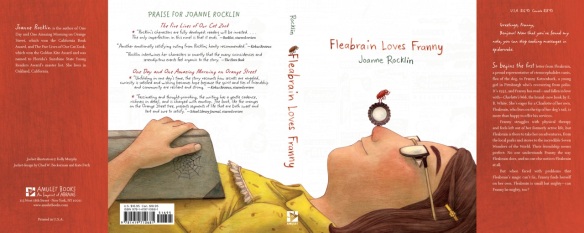
FIVE THINGS LEARNED WHILE WRITING MY MIDDLE GRADE NOVEL FLEABRAIN LOVES FRANNY
My novel takes place in the 1950’s in Pittsburgh, during the worst polio epidemics of that era. Franny, my main character contracts the disease and can no longer walk. During her hospital stay she is introduced to the recently published Charlotte’s Web by E.B. White, and falls in love with the book, and, especially, the spider, Charlotte. She longs for a Charlotte of her own. Her wish is granted in the form of the brilliant Fleabrain, her dog’s flea.
1.
Much of what I learned while writing FLEABRAIN LOVES FRANNY were writing concepts I had to learn yet again, concepts that are integral to my own personal writing process. I usually begin with a phrase which arrives out of the blue. The phrase feels promising but doesn’t reveal much about the book I’m going to write. The phrase for this book was “you can stop seeking messages in spider webs.” This was Fleabrain’s first message to Franny, although I didn’t know it yet. I had to remember to just go with the phrase and wildly thrash about while I figure out what it means. I had to learn yet again, that for me, the rough draft is messy and chaotic but eventually leads to the story.
2.
Fleabrain provided Franny a necessary escape while she healed, as well as exciting adventures, affection, companionship and joy. He also taught her when it was time to face the real world. Fleabrain taught me, yet again, that humor will always be present in my books, no matter the seriousness of the subject matter, and that’s a good thing.
3.
Research is an ongoing process. I began reading about this particular era and began to get ideas about my character and her dilemma. I realized I had to set it in Pittsburgh because that’s where Dr. Jonas Salk did his important research on the polio vaccine, and I wanted to include a scientist in the story. But I was already deep into my story when I realized I would have to visit Pittsburgh and interview Pittsburghers who remembered that time. My research kept giving me ideas for scenes and themes for subsequent drafts.
4.
A surprising thing I learned while researching and writing this book was that many, many people knew very little about the polio epidemics. Some had never heard of an iron lung, or any of the treatment methods and medical advances associated with polio. Many were surprised to learn about the isolation and prejudice experienced by those stricken, and that most of the young people were required to attend special schools for “crippled” children. In addition, I myself learned that polio survivors were at the very forefront of the disability movement, agitating for many of the things we take for granted today (curb cuts, handicapped-accessible public places, etc.).
5.
And so, I learned yet again that the theme of my story will only become clear to me during the writing of the book itself, not before, and sometimes at the very end of the process. One of the important things that Franny learned is that it is not she who needs to be repaired by learning to walk again, but society itself, in accepting her.New picture book:
Joanne’s picture book: I SAY SHEHECHYANU will be out in January, 2015
Visit Joanne at: http://www.joannerocklin.com


By: darlenebeckjacobson,
on 8/7/2014
Blog:
Darlene Beck-Jacobson
(
Login to Add to MyJacketFlap)
JacketFlap tags:
Children's Books,
Book Reviews,
Publishers,
Author Interview,
writing for children,
stories for children,
web sites,
Flu.gov,
Sky Pony Press,
yvonneventresca.com,
Add a tag
Today’s post comes from my writer friend Yvonne Ventresca whose debut YA novel PANDEMIC, hit bookstores in May.
BOOKLIST has this to say about Pandemic:
“Ventresca gives Lilianna a compulsive need to prep for disaster (a coping skill after her assault) and a father who works for a journal called Infectious Diseases. This ups the believability factor and helps the reader focus on the action and characters. As is to be expected in an apocalyptic novel, there is no shortage of tension or death and a few gruesomely dead bodies, but teen disaster fans will likely appreciate that the high schoolers are portrayed as good, helpful people, but certainly not perfect. This fast read will appeal to fans of Susan Beth Pfeffer’s Life As We Knew It (2006), even though the type of apocalypse is different.”
After reading this engaging and suspenseful novel, I can certainly agree that it is, indeed, hard to put down. Ventresca did a wonderful job of making me feel like I was part of the “going’s -on” and even checked my own pantry to see what kind of provisions I had on hand. Here’s Yvonne:
Five Historical Facts I Learned While Researching a Contemporary Pandemic
By Yvonne Ventresca
My debut young adult novel, Pandemic, is a contemporary story about a teenager struggling to survive a deadly flu pandemic. Although it is set in present-day New Jersey (what would it be like if a pandemic hit suburbia tomorrow?), I spent a lot of time researching the Spanish Flu of 1918 while writing the book. Parts of my fictional disease are based on the historical influenza, and I was interested in finding out as much about it as possible. 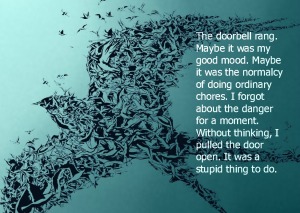
Here are five things I learned while researching Pandemic:
1. The influenza pandemic of 1918 is commonly called the Spanish Flu, but it didn’t originate in Spain. In March of that year, known cases occurred among soldiers in Kansas. But in June, Spain informed the world of a new disease in Madrid, and the Spanish Flu was belatedly named as it spread worldwide.
2. The Spanish flu had a different mortality pattern than previous flu outbreaks, with the highest death rates occurring in adults between the ages of twenty and fifty. The reasons for that pattern are still not entirely understood, but according to the US website Flu.gov, the 1918 virus “evolved directly from a bird flu into a human flu.”
3. In a time before technology, colored ribbons were placed on doorways to indicate a death in the household. The color of the ribbon indicated the age range of the dead. White, for example, was used for children. 
4. In 1918, sanitation measures included wearing face masks, blow-torching water fountains, hosing down streets, and locking public phone booths. Despite these measures, the Spanish flu killed more Americans than all of World War I.
5. Katherine Anne Porter’s short novel, Pale Horse, Pale Rider is set during the 1918 Influenza. It’s a work of fiction (published in 1939), but was no doubt influenced by Porter’s memories of the pandemic and her own illness. The tragic story provides a sense of the war, the disease, and the desperation of that time.
For resources about preparing for an emergency, visit yvonneventresca.com/resources.html.
For more information about the Spanish flu, refer to:
Emerging Epidemics: The Menace of New Infections by Madeline Drexler http://www.goodreads.com/book/show/7444179-emerging-epidemics
The Great Influenza: The Story of the Deadliest Pandemic in History by John M. Barry
http://www.goodreads.com/book/show/29036.The_Great_Influenza
Influenza 1918: The Worst Epidemic in American History by Lynette Iezzoni http://www.goodreads.com/book/show/625882.Influenza_1918
“Pandemic Flu History” http://www.flu.gov/pandemic/history/index.html
Before becoming a children’s writer, Yvonne Ventresca wrote computer programs and taught others how to use technology. Now she happily spends her days writing stories instead of code and sharing technology tips with other writers. Yvonne’s the author of the young adult novel Pandemic, which was published in May from Sky Pony Press. She blogs for teen writers every Tuesday and for writers of all ages each Friday at http://www.yvonneventresca.com/blog.html. 
To connect with Yvonne:
Website: http://www.yvonneventresca.com
Facebook Author http://www.facebook.com/yvonneventrescaauthor
Twitter twitter.com/YvonneVentresca
Goodreads http://www.goodreads.com/author/show/317481.Yvonne_Ventresca
Pinterest: http://www.pinterest.com/yvonneventresca


My friend and fellow blogger Kathy Temean ( http://www.kathytemean.wordpress.com) posted this information about a west coast workshop event for teens seriously interested in learning the craft of writing for children:
TeenSpeak Novel Workshop
Convenes October 17-19, 2014 in coastal Santa Cruz, CA.
TeenSpeak offers a rare opportunity for international teens to interact with top level East Coast editors and agents, and adults who write for the teen/tween market. Open to 10 teens in an intimate setting, the event dovetails with 20 supportive adults in a concurrent, partly overlapping workshop.
FACULTY: Core teen instructor is Helen Pyne, MFA (Vermont College of Fine Arts), a former Doubleday children’s/YA book editor. Along with adult enrollees, teens enjoy novel crafting sessions with Knopf Associate Publishing Director Melanie Cecka (also an award-winning children’s book author) and agent Scott Treimel (former children’s book editor), president of Scott Treimel New York.
CONTENT: TeenSpeak workshop focuses on craft through dramatic improv and other vehicles. Teens receive in-person, mini critiques with editor and agent—and full critiques from their own instructor, and volunteer adult enrollees.
In reciprocity, teens offer adults target-reader feedback. After teens edit selected adults’ partial and full novels, they hear our editor and agent critique the same manuscripts. Lively discussion follows, for the benefit of all: “I loved the teens’ insights at this workshop,” says Erin Clarke, executive editor at Knopf Children’s Books. Well before the event, teens are offered tools to sharpen their critiquing skills, and may be paid for a job well done.
FEE: $549 covers up to three nights’ beachfront condo lodging with chaperone, kid-friendly meals, all critiques, and focus sessions.
TeenSpeak Scholarship Fund: This year’s donations will honor renowned children’s author, Elaine Marie Alphin. Teens (and adults) will apply exercises in her book, Creating Characters Kids Will Love. To contribute any amount to support a young person passionate about writing, contact us via the website, where you’ll find mixed testimonials from scholarship beneficiaries and other enthusiastic teens. (Alternately, ask about possible jobs for teens or parents, or split payments.) Teens appreciate your generous donation!
ENROLLING: Recommended enrollment date for maximum options: July 20. Details and contact: http://www.ChildrensWritersWorkshop.com(click FOR TEENS). TeenSpeak is an outgrowth of the Pacific Coast Children’s Writers Workshop, established 2003. Don’t delay; we fill fast!


By: darlenebeckjacobson,
on 7/6/2014
Blog:
Darlene Beck-Jacobson
(
Login to Add to MyJacketFlap)
JacketFlap tags:
Tips for writers,
Conrad Wesselhoeft,
houghtonmifflin.com,
Children's Books,
Books,
Inspiration,
Author Interview,
writing for children,
YA Books,
stories for children,
Add a tag
First a synopsis of Dirt Bikes, Drones, and Other Ways to Fly:
Seventeen-year-old Arlo Santiago lives in a dusty corner of New Mexico where his two passions are riding dirt bikes and playing a video game called “Drone Pilot.” He’s so good at the game that the military hires him to fly real drones over Pakistan. However, Arlo is reeling emotionally from a violent death in his family. Will he take the military’s money and commit violence against a terrorist leader half a world away, or find another solution to his troubles? He’s got a lot of them, including a father who drinks, a sister with Huntington’s Disease, and a girlfriend who won’t let him run from his past. 
How did the idea for Dirt Bikes, Drones, and Other Ways to Fly originate?
It grew out of my interest in—and concern about—drone warfare, which offers today’s militaries “capability without vulnerability.” As Arlo’s dad says, “Capability without vulnerability! Where are the heroics in that?” I was interested in several themes. One was the idea that violence against the individual is, in fact, violence against society as a whole. Another focused on the importance of friendship and family in dealing with grief. A third was the tendency of technology to outpace human wisdom.
Tells us a bit more about the story.
Arlo’s mom was a victim of violence. His father, a laid-off newspaper editor, is a pacifist. The family desperately needs money to help Arlo’s younger sister, and Arlo is poised to become a major breadwinner. He joins the drone-missile program as an adventure, without considering the moral ramifications. But he grows increasingly troubled at the thought of the violence he might commit.
So the story raises moral questions for Arlo?
Yes, it hinges on the moral dilemma between what seems right at a universal human level—one that values all life—versus what would provide immediate help to Arlo and his struggling family. It’s the tension between what he wants to do and what he feels he should do.
Like Arlo’s dad, you worked in northeast New Mexico as a newspaper editor. Is the book autobiographical?
Only in small ways. For example, Arlo owns a scruffy standard poodle named El Guapo. I own a scruffy standard poodle named Django.
What path led you to writing novels for young adults?
Years ago, I met the acclaimed young-adult author Scott O’Dell (Island of the Blue Dolphins, Sing Down the Moon, and many more). I shared my literary dreams with him, and he urged me to start writing a novel immediately, not to concoct excuses or bog down in planning. That day is one of the most important of my life. It set me on the path to writing YA fiction.
Why do you write for young adults?
I thought it would be easier than writing for grownups. (Man, was I was wrong.) Also, I had three teenagers in my life. My son, in particular, liked to bring home a pack of “big-personality” buddies whose collective voice mixed confidence, arrogance, enthusiasm, laziness, courage, cowardice, cadence, and more. I’d be doing dishes or driving them somewhere and these boys would be handing me golden nuggets, so to speak. They became role models for “The Thicks” in my first book, Adios, Nirvana.
How would you describe your writing process?
Kurt Vonnegut divided all writers into two groups, “bashers” and “swoopers.” I’m a basher, a slow writer who tries to perfect each paragraph before moving to the next. (Swoopers are fast, yet a bit sloppy.) In the morning, I pour some coffee, and get to work. I bash and bash. Only when I’ve bashed all the bumps down to practically dust do I move to the next chapter. I wish I bashed less and swooped more. The best I can hope for is “swashing.”
What have you learned about yourself through the process of writing both Adios, Nirvana and Dirt Bikes, Drones and Other Ways To Fly?
I’ve learned that metaphor can be good medicine. Sometimes, it’s difficult for me to deal directly with emotional pain. In writing fiction, I’m able to project my shadow onto the wall of a different cave and, in doing so, work through my issues. As the story unfolds, the characters and I journey toward greater self-understanding. It’s a roundabout process, but it works.
Dirt Bikes, Drones, and Other Ways to Fly is a novel that clearly provides hope for the future. How important do you think it is to have that note of hope in a novel for young adults?
Hope is extremely important. I choose themes that are important to me. Foremost among these are hope, healing, family, and friendship. These are themes I’d like my own children to embrace. Life can be hard and seem hopeless, so as a writer I choose to send out that “ripple of hope” on the chance it may be heard or felt, and so make a difference.
And finally, what advice would you give to teens struggling to break away from peer group-imposed identities and create a sense of self?
All of us are great people in the making. One doesn’t have to be rich, famous, brilliant, beautiful, or an outward success to be great. One of my favorite examples from fiction is the fisherman Santiago in Hemingway’s The Old Man and the Sea. (Trivial fact: I named my main character Arlo Santiago after Hemingway’s old man.) In the Hemingway book, Santiago starts out poor and ends up poorer. However, in the course of the story, he tests himself to the limit. We see his strength, courage, humility, nobility, and hopeful spirit. Each time we take a step closer to who we really are we get stronger. So my thought would be, if you can’t take big steps toward your goal now, take small ones. As with all goals (including writing YA fiction), time is your friend. So to teens who are struggling, I say be patient, practice, persevere, believe in yourself. Never give up.

Conrad Wesselhoeft worked as a tugboat hand in Singapore and Peace Corps Volunteer in Polynesia before embarking on a career in journalism. He has served on the editorial staffs of five newspapers, including The New York Times. He is the author of the young adult novels Adios, Nirvana (Houghton Mifflin, 2010) and Dirt Bikes, Drones, and Other Ways to Fly (Houghton Mifflin, 2014).


This weekend I had the pleasure of attending the annual NJSCBWI Conference held at the Crowne Plaza Hotel in Princeton, NJ. It’s a great weekend of reconnecting with friends in the writing world. It’s also a chance to network with agents and editors looking for the best  in children’s writing. In addition to the Keynote address on Saturday by Illustrator Floyd Cooper. He demonstrated one of his techniques of illustrating with an eraser. Amazing!
in children’s writing. In addition to the Keynote address on Saturday by Illustrator Floyd Cooper. He demonstrated one of his techniques of illustrating with an eraser. Amazing!
We enjoyed workshops on every aspect of the art of writing for children. Saturday and Sunday were filled with these “mini” lessons on how to: craft the perfect Picture Book, develop characters, write for magazines, write non-fiction, write a query, find out what editors and agents are looking for and much more. There was a book fair with a chance to buy autographed copies of books and meet authors from all over the world.
We also enjoyed a hilarious hour of stand up comedy by Robin Fox. 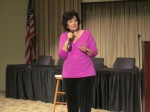
The conference is always inspiring and re-energizes me with new ideas. And, I got to show off my book with my Agent Liza Fleissig…even though it won’t go on sale until September. 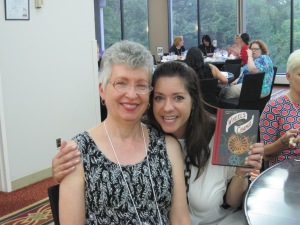
Here are some photos of the weekend. For more about the conference visit: http://www.njscbwi.com
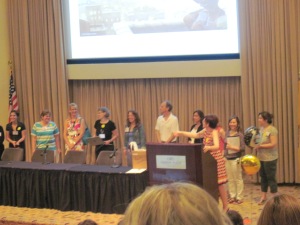
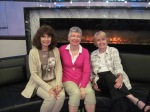
With Shiela Fuller and Jody Staton
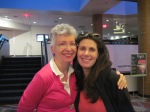
With Marina Cohen
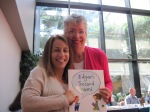
with author Audrey Vernick


By: darlenebeckjacobson,
on 6/26/2014
Blog:
Darlene Beck-Jacobson
(
Login to Add to MyJacketFlap)
JacketFlap tags:
Children,
Books,
Activities,
stories for children,
web sites,
summer fun,
Home Schooling Ideas,
Ideas for summer reading and literacy,
www.Education.com,
Add a tag
As promised last week, Gail Terp is back with a wonderful post about encouraging reading and literacy throughout the summer. Here’s Gail:
Summer is a great time to bring home the message that reading is fun. It’s a time for reading just what you want, rereading favorites as often as you choose, discovering new information, and listening to great stories in a leisurely way.
Summer is a time to leave homework and reading instruction behind. It’s all about reading pleasure and practice. Just let it flow….
Although I run a reading tips post every summer, each year I find new ideas. Here are some old and new ideas for you to consider.
Be a reader yourself. Show your kids that you value reading by reading yourself.
Read aloud, read aloud, read aloud! Be creative—read alouds aren’t just for bedtime. Try between chores, while waiting for appointments, dinner to be done, food in a restaurant, standing in line…
Listen to audio books. Car trips are a perfect time to listen to audio books. They give a shared experience and can spark conversation. Kids can often listen to a higher level book than they can read. They’re great vocabulary builders, too!
Ask friends and classmates for reading recommendations. And don’t stop there—ask relatives, neighbors, and other trusted adults about their favorite books when they were kids. This could set your kids down brand new reading avenues!
Allow your child to choose his books. Summer is for fun! Sure, we want to learn too, but fun comes first. Don’t get hung up on the reading level. Let you child choose what is interesting.
Read the newspaper. Newspaper writing can be tricky, but some is very straightforward. Let your child choose a story and you can read it together. See an interesting picture? Try to guess its caption and/or write a new one.
Write new words to a favorite tune. This is a wonderfully creative idea and could be hilarious!
Write stories and plays. This is a time for creativity, not writing instruction. If your child wants help, he’ll ask, otherwise, let it be all about ideas.
Write letters Letters can take all forms: emails, postcards, letters, paper airplanes… Try designing your own stationery and postcards. Create a box or bucket of fun writing materials—paper, cardstock, markers, fancy pens and pencils, glitter… Send to: friends, relatives, authors, experts…
Board Games. Many games have a reading component, and even if they don’t, play them anyway because they’re fun!
Don’t limit summer reading to books. Try magazines. Your library probably has a good selection to start with. Also try brochures, comics, directions, maps, atlases, cereal boxes…
Read a book and watch the movie together. This works for movies in theaters and movies you rent or get from the library.
Reread your favorites Summer is a great time to read old favorites, either independently or as a read aloud. Maybe create a shared book list of everyone’s favorite kids’ books. Then trade books!
Check out reading programs at your library Many local libraries have summer programs. Some schools do, too.
5 more ways to motivate summer reading Click here for ideas from Education.com
Resources used to compile this list: 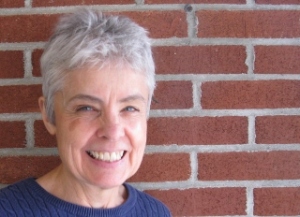
PBS Parents
Reading Rockets
North Shore Pediatric Therapy
NCLD
Education.com
Living Montessori Now
Teach Preschool


Everyone who loves books for children has their favorites. Those special books that have left a mark or demand to be read over and over again. So here are 30 of mine…in no particular order. Some are old classics, others new. Some picture books, middle grade and young adult. All are wonderful additions to every child’s library.
Picture Books:
The Cat in the Hat – Dr. Suess
Leo the Late Bloomer – Jose Aruego
The Runaway Bunny/Goodnight Moon – Margaret Wise Brown
The Day the Crayons Quit – Drew Daywalt
Inside the Slidy Diner – Laurel Snyder
Middle Grade:
Anne of Green Gables – L M Montgomery
Diary of a Young Girl – Anne Frank
Charlotte’s Web – E B White
Because of Winn Dixie – Kate DiCamillo
A Northern Light – Jennifer Donnelly
Harry Potter Books –J K Rowling
The Graveyard Book – Neil Gaiman
Chains – Laurie Halse Anderson
The Evolution of Calpurnia Tate – Jacqueline Kelly
The Midwife’s Apprentice – Karen Cushman
The Phantom Toolbooth – Norton Juster
Ramona Quimby series – Beverly Cleary
An Unfinished Angel – Sharon Creech
Moon Over Manifest – Clare Vanderpool
Flora and Ulysses – Kate DiCamillo
One Day and One Amazing Morning on Orange Street – Joanne Rocklin
When Audrey Met Alice – Rebecca Behrens
The Junction of Sunshine and Lucky – Holly Schindler
Glory Be – Augusta Scattergood
The One and Only Ivan – Katherine Applegate
Wonder – R J Palacio
Young Adult:
The Absolutely True Diary of a Part Time Indian – Sherman Alexie
The Sisterhood of the Traveling Pants Series – Anna Brashares
13 Reasons Why – Jay Asher
The Fault in Our Stars – John Green
Which treasured books would you add to this list?


Today’s post comes from a fellow writer, Johanna “Jody” Staton about how she finds and keeps ideas for writing. Here’s Jody:
Even when we enjoy writing and want to do it, we always seem to have excuses not to be doing more of it: school, jobs, family plans and obligations.
For me, there was one more excuse: no ideas that grabbed me by fingertips and dragged me to the keyboard. Until I read a column in a writers’ magazine that suggested keeping an “idea dump.” So I started one.
I’ve always gotten a daily newspaper, a habit learned from my grandfather and reinforced in journalism classes. Skimming the headlines gave me a general idea what was going on in the world. If the headline hooked me and the lead paragraph reeled me in, a whole article gave me insight into people and stories I didn’t know about before.
My mother had frequently clipped articles that she sent to me in college. Off on my own, I rarely cut anything out of the paper, until I read that “idea dump” column.
Space was made in a file cabinet. Out came the manila folders, the scissors. My husband read the newspaper first, because it developed holes once I got hold of it. Magazines were divested of entire pages. 
The folders multiplied like rabbits. “Characters” became a bigger hanging box-bottomed folder housing “Children,” “Teens,” etc. “Settings” got geographical divisions. For articles from the writing magazine, genres each had their own folder, as did various aspects of the writing craft.
The following outline is an example of just some of the folders in my “idea dump”:
Animals
animal behavior
birds
cats
dogs
farm animals
ferrets
horses
people who work with animals
shelters
unicorns
wild animals
working animals
Characters
children
clothes
cultures
disabilities
faces
language
men
names
talents
teens
women
Concepts
art
dance
government
learning
music
Genres
fantasy
humor
middle grades books
mystery
picture books
romance
science fiction
travel writing
young adult books
Settings
housing types
military
ocean
other planets
schools
Specific locations
America
England
Europe
my home town
my region
my state
other countries
other states
Writing advice
plotting
point of view
titles
Can I claim that each of those clippings resulted in a writings project—a story, an essay, an article, a novel? No. But what I do know is that once I followed the column’s advice and started my own “idea dump,” something must have gotten turned on in my brain, so that now I have enough ideas for novels to keep me writing forevermore. 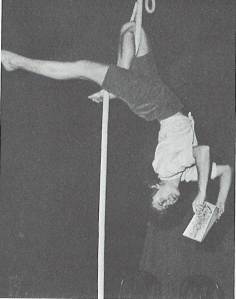
How do you organize/sort/keep your ideas for possible stories?
Jody Staton first realized she wanted to be a writer when she was twelve, and won an award at summer camp for the best writing of the season, a paragraph titled “God’s Symphony.” She worked for her high school and college newspapers, and was an English major. She has a graduate degree in magazine journalism. Jody was also an editor at Jack and Jill magazine, and had stories and articles published there and elsewhere. She does freelance copy editing, and has written several middle grade and young adult novels, all in various stages of development. None are published yet, but some have gotten favorable comments from agents and editors. She is currently working on a horsey historical for upper middle grades.


By: Virginia S Grenier,
on 5/18/2014
Blog:
Utah Children's Writers
(
Login to Add to MyJacketFlap)
JacketFlap tags:
tips for crafting a picture book,
celebrating great authors,
Utah writing community,
podcast,
Author Interview,
stories for children,
blog talk radio,
How To,
books for young readers,
live chat,
Add a tag

The Stories for Children show is on Mondays and hosted by Mom's Choice and Award-winning Author Virginia S Grenier, who is joined weekly by guest authors to talk about writing for children and/or their favorite children's/YA books. Grenier, with her guests, hope to not only share their love of the written word, but also what makes a good book for young readers and much more.
This week on Monday May 19, 2014 at 3pm Pacific - 4pm Mountain - 5pm Central - 6pm Eastern, Grenier will be joined by two members of the Utah Children's Writers blog team.
Our guests are: Scott Rhoades has enjoyed writing since he was about five years old, when he used to make his own books by tracing pictures and making up stories to go with them. He especially enjoys writing stories set in the Middle Ages. He was a technical writer for Novell, Inc. from 1992 to 2007, after starting his career at Atari in 1988. He currently runs his own company,
Write Field Documentation Services, LLC. He is also on the Board of Directors of The Tiferet Center, a center for Jewish education, ritual, and community service based in Vermont. Learn more at
http://www.scottrhoades.com/index.html Julie Daines spent eighteen months in London where she studied and fell in love with English Literature, Sticky Toffee Pudding, and the fellow who ran the kebab store around the corner. After editing for other authors, she decided to take up writing again--this time in the young adult genre. Learn more at
http://www.juliedaines.com/Writers are invited to call-in during the show at (714) 242-5259 or join us in our chatroom located on the show page (
http://www.blogtalkradio.com/worldofinknetwork/2014/05/19/utah-childrens-writers--the-stories-for-children-show)!
Learn more about our shows and network at our website
http://worldofinknetwork.com Find great books and articles on
our blog or follow us on our
Facebook Fanpage You can also catch the show through Facebook, Twitter, itunes and many more!
Listen in Monday May 19th at 4pm Mountain at
http://www.blogtalkradio.com/worldofinknetwork/2014/05/19/utah-childrens-writers--the-stories-for-children-show
By: darlenebeckjacobson,
on 5/15/2014
Blog:
Darlene Beck-Jacobson
(
Login to Add to MyJacketFlap)
JacketFlap tags:
Rebecca Behrens,
Robin Herrera,
Children's Books,
Book Reviews,
Books,
stories for children,
Holly Black,
Ingrid Law,
Thanhha Lai,
Add a tag
I’ve been reading a lot of great middle grade books lately and want to share some of them with you. They are perfect for summer days and beyond.
SAVVY by Ingrid Law follows the adventures of Mississippi “Mibs” Beaumont who is about to turn 13. It’s the magical birthday in the Beaumont family when a family member’s Savvy first shows itself. Will Mibs’ savvy be as fierce as her brother Rocket’s – who creates electricity? Or like her brother Fish’s who produces hurricanes? And, will her Savvy be enough to save her Poppa who lies in the hospital in a coma? This is a delightful tale of family, friendship and love, and a ride on a pink bus that changes everything.
DOLL BONES by Holly Black follows the exploits of Poppy, Zac, and Alice who go on a modern day quest to bring the ghost of Eleanor – housed inside a china doll called Queen – to rest. This ghostly tale is also one of friendship, growing up, and having the courage to risk everything.
HOPE IS A FERRIS WHEEL by Robin Herrera is another winner. Star Mackie’s voice rings unique and true in a tale of friendship, love, acceptance, and letting your own star shine, no matter what. Using Emily Dickenson’s poem “Hope is the thing with feathers”, Star and her Poetry Club friends find their own versions of hope.
The Newbery Honor and National Book Award winner INSIDE OUT AND BACK AGAIN by Thanhha Lai, uses poetic form the tell the story of a young Vietnamese girl Ha’ and her family. They are forced to leave their beloved Saigon when it falls during the war in 1975. They board a ship to the US where Ha’ must find her place in a strange and foreign land called Alabama. Beautifully written, heartfelt and tender, it’s an unforgettable story about the people war leaves behind.
WHEN AUDREY MET ALICE by Rebecca Behrens tells the tale of First Daughter (to a woman president) Audrey, who has a hard time adjusting to the strict rules of living at the White House. She finds help and inspiration when she discovers the hidden diary of another First Daughter, Alice Roosevelt. It’s an engaging look at how both girls had to behave in the past as well as the present.
I hope you enjoy reading these wonderful books as much as I did.


Picture Book Writer, and workshop presenter extraordinaire, Sudipta Bardhan-Quallan is hosting a web-based workshop on using poetic techniques in Picture Book writing. This 5 week, interactive and flexible e-Course is unlike anything else for enhancing the art of picture book writing. The course begins on MAY 19, 2014. To register and check out the details: Poetry Course Flyer.
Here’s the link to the website and program: http://www.childrensbookacademy.com/the-great-discounts-pleasures-and-craft-of-poetic-techniques.html
You can visit Sudipta at her website: http://www.sudipta.com


Many thanks to Roseanne Kurstedt and her generous book give-away of AND I THOUGHT ABOUT YOU. I’d also like to thank those who left comments and entered the contest. Without further ado, I picked the following names from those who entered:
Kristi Vieten and Robin Newman. Congratulations Ladies! Roseanne will be in touch. Happy Mother’s Day to all!


By: darlenebeckjacobson,
on 5/4/2014
Blog:
Darlene Beck-Jacobson
(
Login to Add to MyJacketFlap)
JacketFlap tags:
free book for Mother's Day,
www.rlkurstedt.com,
Children,
Books,
Inspiration,
Author Interview,
writing for children,
stories for children,
Home Schooling Ideas,
Add a tag
First, I’d like to thank Darlene for inviting me to her blog so I can talk about my book, And I Thought About You in honor of Mother’s day, and to touch upon the importance of establishing routines. 
Routines help us be present. They provide a sense of calm and comfort. But they also provide a space where magical things can happen.
I began this post discussing routines, because my book And I Thought About You was inspired by a bedtime routine my son and I created while we lived in Hong Kong. His bedtime routine was bath, books, and bed – not so out of the ordinary I’m sure – but inevitably between the books and bed we would discuss what we did throughout the day. One night, one of us – I can’t remember who – ended the discussion with “and I thought about you” (the magic).
At the time I was working full time, so this nightly routine was something I cherished, especially the “and I thought about you” aspect—it was so simple, yet so true.
When I was writing in my writing notebook (a routine that helps me develop my writing), it occurred to me how wonderfully our nightly routine might work as a picture book. After all, wondering what your child is doing when you’re not with them is a universally shared sentiment, one that all mothers feel. In addition, I believe that it is these small interactions that develop deep family connections and fuel childhood memories.
Surprisingly, as I wrote this post, I began to realize that the idea of setting routines to provide space for the magic to happen applies to writing too—since once the routine is established there is room for you to concentrate or focus on the perfect word choice, character description, or plot twist.
So in celebration of mothers, writers and the routines that nurture “the magic,” I hope you’ll take a moment to share some or your own family or writing routines.
What kind of rituals do you share with your child? I’d love to hear about them.
Thanks again Darlene for inviting me to stop by. And Happy Mother’s Day!!

Rosanne Kurstedt has a Ph.D. in education and is the author of self-published book, And I thought About You (illustrated by Lisa Carletta-Vietes), an honorable mention recipient at the New England Book Festival and the New York Book Festival. She was also the recipient of a 2013 Barbara Karlin Grant Letter of Commendation. In addition, Rosanne writes professional books for teachers, including Teaching Writing With Picture Books as Models (Scholastic, 2000). You can visit Rosanne at http://www.rlkurstedt.com, or at her blog, http://rlkurstedt.wordpress.com, and on Facebook.
Roseanne would like to give away a free copy of And I Thought About You to two lucky followers of this blog. Your name will be entered once for posting a comment, once for tweeting this post on Twitter, and twice for posting it on your Face Book page. Mention in an e-mail or by leaving a comment how many times your name should be entered. I will then draw two names at random and announce the winners. You have until 10PM on Mother’s Day 5-11-2014 to enter.


View Next 25 Posts


















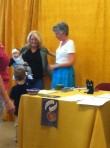
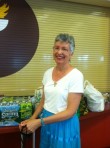
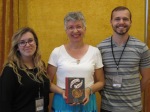
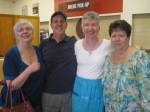

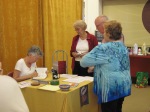


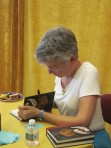
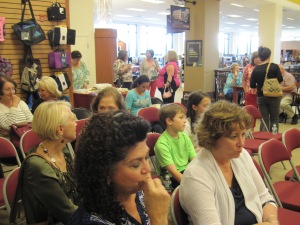






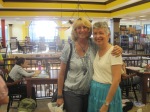

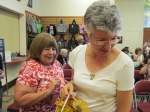

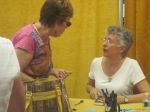
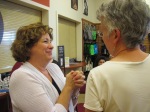
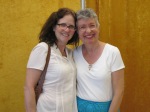
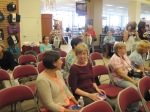
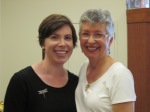

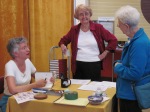
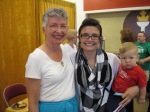
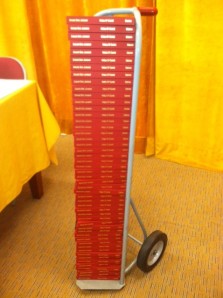
























Nancy, Thanks so much for sharing this info. With my first book coming out in the spring, I’ve been wondering a lot about how to get the word out on the book.
Robin,
I am thrilled to have recently been accepted into membership with the Kid Lit Club! It’s wonderful to have the support and expertise of fellow authors while we navigate the world of book promotion. Thanks for your comment and for your continued support.
This is terrific, ladies :) And it’s so nice to see familiar, smiling faces in that pic!